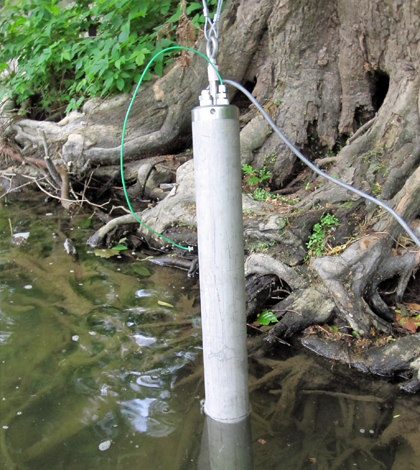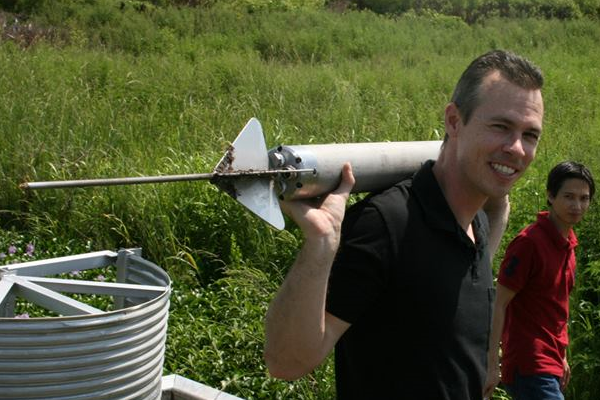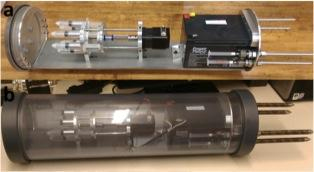New Tool Tracks Chemical Compounds Directly In Water

An earlier version of the in-situ sampling device. The lower portion of the tubular instrument is submerged in sediment while the upper portion is exposed to pore water. (Credit: Arizona State University)
For common water quality parameters like pH or dissolved oxygen, there are plenty of devices out there to measure them. For low-level contaminants like pesticides, however, the situation is a little trickier.
A tried-and-true method of acquiring chemical contaminant data has traditionally involved collecting “grab samples” by dipping bottles into the target water source and then transporting those bottles, which are often very heavy when they are full of water, to a lab for analysis. The trouble with this method is that the sample is from a single point in time and may not represent fluctuations in the contaminant that occur over weeks or months. Additionally, collecting water and shipping it to a lab for analysis can be expensive and something of a hassle.
If only there were a way to make sample transport easy, while also providing samples that accurately reflect contaminant levels. Such a method would help researchers and natural resources managers better understand the contamination issues at their sites, save some money, and perhaps save some field techs a little back strain.
Some researchers at Arizona State University have tried their hand at addressing this issue. They have developed a sampling device that integrates some of the same equipment used in the lab to enhance the signal of low-level chemical compounds; it is a device capable of collecting the chemicals directly from water, without collecting the water itself.
One of the key features of the device, aside from its ability to capture chemicals from water, is its unique ability to sample contaminants in bulk water and the sediment pore water (e.g., in a lake) simultaneously. The device was recently used in waterways of the U.S. Southwest to assess the occurrence of the pesticide fipronil, which may play a role in the plight of honeybee populations in the United States.

Samuel Supowit carries the IS2B to a deployment site. (Credit: Samuel Supowit / Arizona State University)
The device is called the In Situ Sampler for Biphasic water assessment (IS2B), and uses solid phase extraction (SPE) technology in its design to concentrate the analytes directly in the stream of interest. SPE involves passing water through a cartridge filled with a selected resin matched to the chemicals of interest. The resin adsorbs the chemicals, effectively precipitating them out of the dissolved phase. The cartridge is subsequently taken back to the lab, the contaminant extracted from the resin using standard analytical methods, and then analyzed.
“We’ve taken that technology and put it into a sampler so that it is done in the field. That technology is very common and as a mature technology, cartridges and resins can be purchased commercially,” said Erin Driver, a graduate research associate at Arizona State University’s Biodesign Institute.
If designing your own resin is not possible, all that you have to do is go online, order the type of cartridge that you need for your specific contaminant, and install it into the sampler, all of which is housed in a tubular shell. The IS2B has ports at the top and bottom that allow for water to be collected or expelled. Pore water is collected through spikes at the base of the unit that have two layers of stainless steel filters, while the overlaying water is collected through top ports. In each case, water is transported through interior manifolds to the SPE cartridges, and then the water with the chemicals extracted is expelled through another port back into the environment.

Second-generation version of the device, known as the IS2B. (Credit: Arizona State University)
“The older design used VitonTM tubing with a peristaltic pump. We now use a syringe pump, which is more consistent, and controlled via computer,” said Driver, referencing the new iteration of the device that is only 2 feet tall and uses PVC construction to allow visual inspection of the workings within, including an integrated battery.
The initial investigation of the device’s utility, led by Dr. Samuel Supowit while a graduate student at Arizona State, showed that the approach produces reliable results.
Dr. Supowit performed a study that compared in situ extraction by the IS2B with grab sample collection and subsequent laboratory extraction. Extractions in both cases were analyzed by liquid chromatography tandem mass spectrometry (LC-MS/MS). Results of the study showed the IS2B as comparable to the traditional approach, but with the additional benefit of providing time-averaged concentrations.
The two methods performed similarly, Driver says, but the IS2B’s method detection limits were more favorable.
“The technologies are the same (SPE) — we’re just wiping out some of the error attributed to sample collection and transport,” said Driver. She adds that the device isn’t limited to tracking any one chemical contaminant. Because it can accommodate commercially available, standard SPE cartridges, it’s easy to track other chemical compounds just by replacing the cartridge, or even to stack them and track several classes of chemicals.
“Anything that you use solid phase extraction for in the lab, you can use this approach,” said Driver. “The sky’s the limit.”
Full results of the device’s first deployment are published on the Arizona State University website. Driver says that work is continuing to further refine the second-generation model.
Top image: An earlier version of the in-situ sampling device. The lower portion of the tubular instrument is submerged in sediment while the upper portion is exposed to pore water. (Credit: Arizona State University)




0 comments